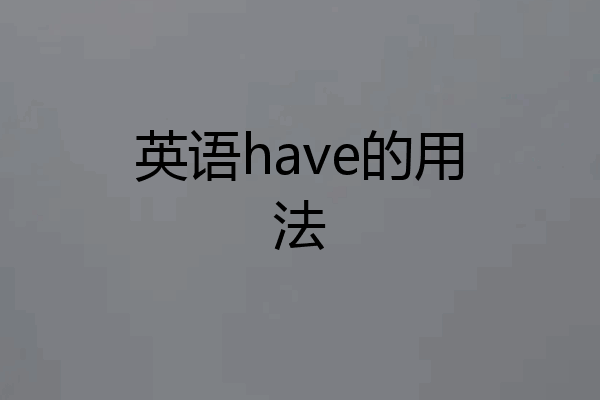
xiaomakuaipao
have、has、had,三种形式分别为:第一、二人称单数,第三人称单数,一般过去式。1、主语为:I(我),You(你),You(你们),We(我们),They(他们) 时,使用have;例如:Ihavemuchworktodo.2、主语为:he(他),she(她)时,用has;例如:Hehassomebooksontheshelf.3、当表示过去时,就用had。例如:Ihad100yuanthreedaysago,butnowIrunoutofthem. 其实have的用法还有很多,譬如havedone(完成时),havesthdone(让某事完成,某事被完成)...


太极武者NO1
词形变化(1)现在式:(I,you,we,they) have (he,she,it) has I've,you've,we've,they've,he's,she's,it's.(2)过去式:(I,you,he,she,it,we,they) had, I'd,you'd,he'd,she'd,we'd,they'd(3)否定省略形:haven't,hasn't,hadn't(4)现在分词:having(5)过去分词:had(6)现在式: has, have过去式: had

漫山红遍
Have实义是“有”的意思,例如ihavesomegirlfriend.(我有很对女朋友)。也可以表示完成式.ihaveeatenlunch(我吃过晚饭了)而对于主语单数第三人称这两种情况下havew要变has。had是他的过去式、ihadanicegirlfriend。例:我以前有个对象。(现在可能有五个,十个。也可能吹了,一个没有。只说明过去。

俺是陆军PLA
通常与介词to 形成短语,have to=must是不得不;必须的意思,相当于一个情态动词,后面加动词原形,构成短语have to do sth.如:I have an apple.我有一个苹果。这的意思是“有”。I have to do my homework.我不得不做我的家庭作业。是必须的意思 have表示”使“时(即用做使役动词)的用法有三种: 1.have sb/sth do sth:表示使某人做某事。 例:The teacher has students do homework every day. 2.have sb/sth doing sth:表示使某人一直做某事 例:He has the horse running all day. 3.have sb/sth done:表示使某人被... 例:He has his hair cut by his father. 单数时,须把have改为has.

lclcjunjun
have是“有”的意思,在陈述句中当主语是其他人称(I、you、we、they)时,句子的谓语是“有”时,用have。1.表示“有”的意思.Look,I have wings,just like you.He had fair hair and blue eyes.〔注1〕:其否定和疑问形式变化,在美国通常用助动词do.〔注2〕:在英国口语中常用have got代替have.Look,can’t you see I've got teeth,too.I haven't got any jewelry.2.have和一些其他名词连用,表示:(1)一种活动.We have no classes on Sunday.(上课)they’re going to have a volleyball match.(举行比赛)Are we going to have a meeting this week?(开会)We are going to have a talk this afternoon.(听报告)(2)患病.I have got a headache.I have a bad cold.(3)发生的情况.I've had so many falls that I'm black and blue all over.(跌跤)(JBⅣL10)(4)生育.The queen ant may have tens of thousands of babies in one summer.3.和一与动词同形的名词连用,表示一个动作(have+a+由动词转化和名词).Are you going to have a swim.I have a long talk with the teacher.4.have on sth.或have sth.on,表示“穿着”、“戴着”(=to be wearing).I noticed he had on bedroom slippers.At the ball Motile had a diamond necklace on.5.表示“吃”、“喝”.I wanted to have a cup of tea and some eggs.Does she have lunch at home?6.组成复合结构即“have+宾语+宾语补足语”.(1)不加to的动词不定式作宾语补足语(have sb.do sth.),表示让、叫某人做某事.The soldier had him stand with his back to his father.〔注〕:否定结构表示“不能让…”或“从未有人…”.We won't have you blame it on others.She had never had anybody speak to her that way before.(2)现在分词作宾语补足语(have sb.(sth.)doing),表示让(使)某人做某事.…the two men had their lights burning all night long….(3)过去分词作宾语补足语(have sb.(sth.)done),表示:①使(让,请)别人作某事,表示的动作是别人做的.Emperor Qin Shi Huang had all the walls joined up.…he should have new clothes made of this splendid cloth for the coming great procession.②遭遇到某事.Houses near airports sometimes have their windows broken.Workers in some industries have their hearing harmed by the noise of the machine.

iamjiaying
Have是英语中最常用的动词之一.它具有双重作用──既可用作助动词,又可用作一般动词.现结合初中英语课本简述如下:一、作助动词,帮助构成各种完成时态:I have just washed my clothes.我刚洗完衣服.When I got there,the train had already left.我到时,火车已经开走了.助动词have和has常可分别缩略为-’ve,-’s.所以I’ve=I have,We’ve=We have,He’s=He has,It’s=It has.但是,当have(has)处于句末时,不能用缩略形式.如:──Have you finished your homework?──Yes,I have.(不能用yes,I’ve.)二、作一般动词,主要有以下几种用法:1.表示“有”;.如:It has no eyes and no ears.它既无眼又无耳.当表示“有”时,have的疑问式和否定式有两种构成方法.第一种方法是不用助动词.把have提到主语前面构成疑问式,在have后加not构成否定式.如:Has Mary any story-books?玛丽有故事书吗?I haven’t any paper.我没有纸.第二种方法是用助动词do构成其疑问式和否定式.如:Do you have any tea here? 你这儿有茶吗?I don’t have a ruler. 我没有尺子.英国人多用第一种方法,美国人多用第二种方法.在两种方法都正确的情况下,应当注意,用哪种形式提问,必须用同样的形式回答.如:A:Have you an eraser?B:Yes,I have.(No,I haven’t.)A:Do you have an eraser?B:Yes,I do.(No,I don’t.)表示“有”时,have不能用进行时.如不能说:I’m having a bike.(×)在口语中,人们常用have got来代替have表示“有”.如:He has got a car.他有一辆车.Have you got a knife? 你有小刀吗?2.和具有动作含义的名词连用.如:Let me have a look.让我看看.We’re going to have a swim in the lake.我们打算在湖中游泳.这样用时,have只表示动作,不表示什么意义,动作的实际内容是其后边的名词所包含的.所以:to have a look=to lookto have a swim=to swimto have a rest=to rest不过,用“have+名词”的形式往往含有“一次”“一会儿”等意思.3.和其他各词连用,表示“上(课)”“吃(饭)”“开(会)”等.如:We have breakfast in the morning.我们早上吃早饭.What lessons did he have yesterday?昨天他上什么课了?They are having a meeting.他们正在开会